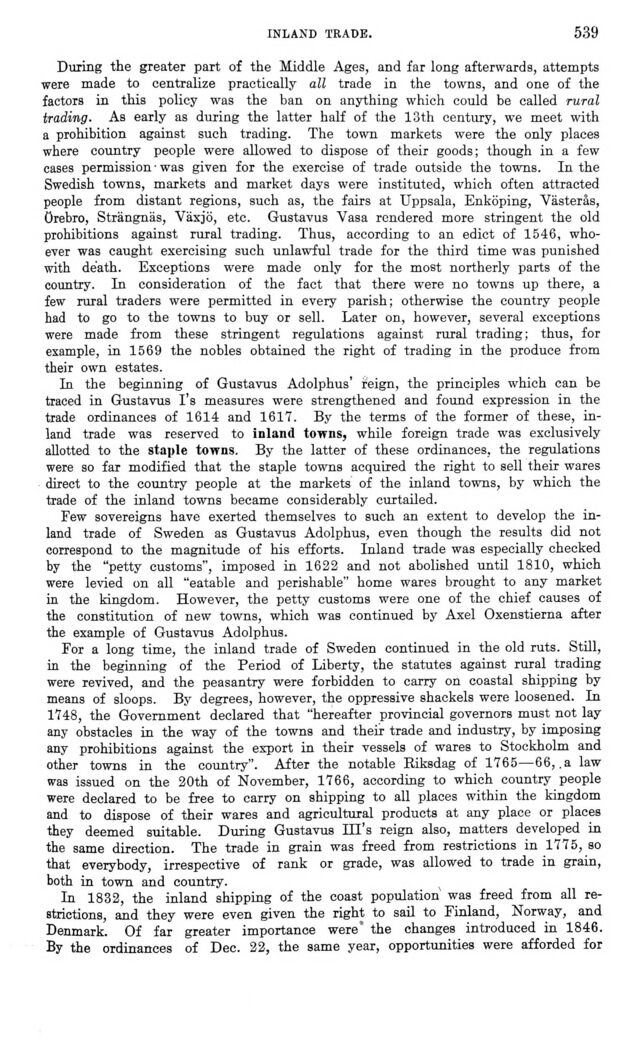
Full resolution (JPEG) - On this page / på denna sida - VIII. Commerce. [By A. Berencreutz] - Inland Trade. By H. Rosman

<< prev. page << föreg. sida << >> nästa sida >> next page >>
Below is the raw OCR text
from the above scanned image.
Do you see an error? Proofread the page now!
Här nedan syns maskintolkade texten från faksimilbilden ovan.
Ser du något fel? Korrekturläs sidan nu!
This page has never been proofread. / Denna sida har aldrig korrekturlästs.
inland trade.
539
During the greater part of the Middle Ages, and far long afterwards, attempts
were made to centralize practically all trade in the towns, and one of the
factors in this policy was the ban on anything which could be called rural
trading. As early as during the latter half of the 13th century, we meet with
a prohibition against such trading. The town markets were the only places
where country people were allowed to dispose of their goods; though in a few
cases permission ■ was given for the exercise of trade outside the towns. In the
Swedish towns, markets and market days were instituted, which often attracted
people from distant regions, such as, the fairs at Uppsala, Enköping, Västerås,
Örebro, Strängnäs, Växjö, etc. Gustavus Vasa rendered more stringent the old
prohibitions against rural trading. Thus, according to an edict of 1546,
whoever was caught exercising such unlawful trade for the third time was punished
with death. Exceptions were made only for the most northerly parts of the
country. In consideration of the fact that there were no towns up there, a
few rural traders were permitted in every parish; otherwise the country people
had to go to the towns to buy or sell. Later on, however, several exceptions
were made from these stringent regulations against rural trading; thus, for
example, in 1569 the nobles obtained the right of trading in the produce from
their own estates.
In the beginning of Gustavus Adolphus’ reign, the principles which can be
traced in Gustavus I’s measures were strengthened and found expression in the
trade ordinances of 1614 and 1617. By the terms of the former of these,
inland trade was reserved to inland towns, while foreign trade was exclusively
allotted to the staple towns. By the latter of these ordinances, the regulations
were so far modified that the staple towns acquired the right to sell their wares
direct to the country people at the markets of the inland towns, by which the
trade of the inland towns became considerably curtailed.
Few sovereigns have exerted themselves to such an extent to develop the
inland trade of Sweden as Gustavus Adolphus, even though the results did not
correspond to the magnitude of his efforts. Inland trade was especially checked
by the "petty customs", imposed in 1622 and not abolished until 1810, which
were levied on all "eatable and perishable" home wares brought to any market
in the kingdom. However, the petty customs were one of the chief causes of
the constitution of new towns, which was continued by Axel Oxenstierna after
the example of Gustavus Adolphus.
For a long time, the inland trade of Sweden continued in the old ruts. Still,
in the beginning of the Period of Liberty, the statutes against rural trading
were revived, and the peasantry were forbidden to carry on coastal shipping by
means of sloops. By degrees, however, the oppressive shackels were loosened. In
1748, the Government declared that "hereafter provincial governors must not lay
any obstacles in the way of the towns and their trade and industry, by imposing
any prohibitions against the export in their vessels of wares to Stockholm and
other towns in the country". After the notable Riksdag of 1765—66, .a law
was issued on the 20th of November, 1766, according to which country people
were declared to be free to carry on shipping to all places within the kingdom
and to dispose of their wares and agricultural products at any place or places
they deemed suitable. During Gustavus Hi’s reign also, matters developed in
the same direction. The trade in grain was freed from restrictions in 1775, so
that everybody, irrespective of rank or grade, was allowed to trade in grain,
both in town and country.
In 1832, the inland shipping of the coast population was freed from all
restrictions, and they were even given the right to sail to Finland, Norway, and
Denmark. Of far greater importance were’ the changes introduced in 1846.
By the ordinances of Dec. 22, the same year, opportunities were afforded for
<< prev. page << föreg. sida << >> nästa sida >> next page >>